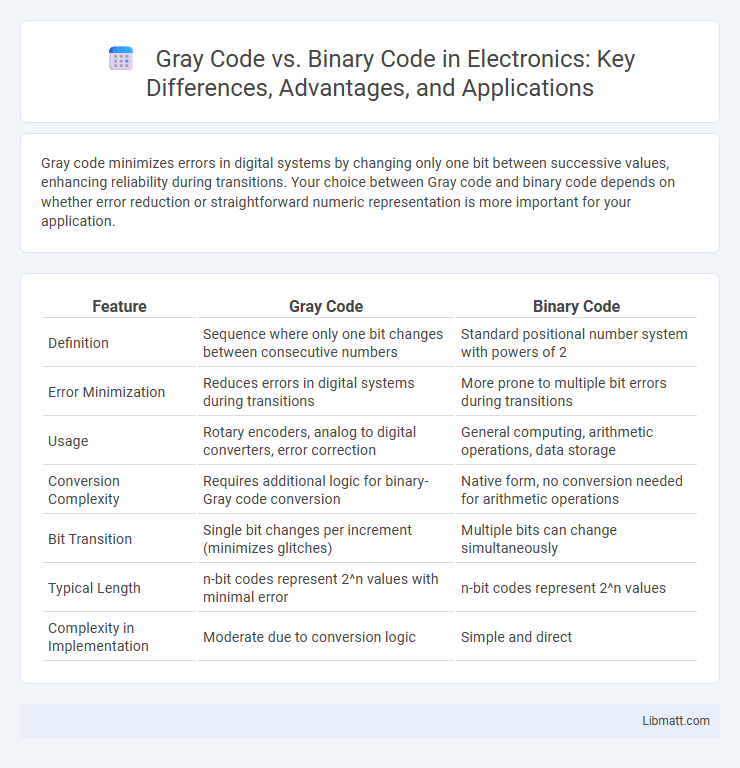Gray code minimizes errors in digital systems by changing only one bit between successive values, enhancing reliability during transitions. Your choice between Gray code and binary code depends on whether error reduction or straightforward numeric representation is more important for your application.
Table of Comparison
| Feature | Gray Code | Binary Code |
|---|---|---|
| Definition | Sequence where only one bit changes between consecutive numbers | Standard positional number system with powers of 2 |
| Error Minimization | Reduces errors in digital systems during transitions | More prone to multiple bit errors during transitions |
| Usage | Rotary encoders, analog to digital converters, error correction | General computing, arithmetic operations, data storage |
| Conversion Complexity | Requires additional logic for binary-Gray code conversion | Native form, no conversion needed for arithmetic operations |
| Bit Transition | Single bit changes per increment (minimizes glitches) | Multiple bits can change simultaneously |
| Typical Length | n-bit codes represent 2^n values with minimal error | n-bit codes represent 2^n values |
| Complexity in Implementation | Moderate due to conversion logic | Simple and direct |
Introduction to Gray Code and Binary Code
Binary code represents data using two distinct symbols, typically 0 and 1, with each bit position contributing a weighted value following the base-2 numeral system. Gray code, also known as reflected binary code, is a binary numeral system where two successive values differ by only one bit, minimizing errors in digital communications and mechanical encoders. In applications requiring error reduction and signal integrity, Gray code offers advantages over standard binary code by preventing spurious transitions during value changes.
Fundamental Differences Between Gray Code and Binary Code
Gray Code differs from Binary Code primarily in its structure, as Gray Code ensures that only one bit changes between consecutive values, reducing errors in digital communication and position encoding. Binary Code represents values using a straightforward combination of bits based on powers of two, which can result in multiple bit changes between adjacent numbers. Understanding these fundamental differences helps you select the appropriate code for error-sensitive applications like rotary encoders and digital signal processing.
Historical Background and Development
Gray Code, developed by Frank Gray in the 1930s, was initially created to minimize errors in digital communication and rotary encoders by ensuring only one bit changes between successive values. In contrast, Binary Code has ancient roots dating back to Leibniz's 17th-century work on base-2 numbering, forming the foundation of modern digital computing and arithmetic. Your understanding of these codes highlights the evolution from error-resistant signaling methods to the complex computational frameworks used today.
How Binary Code Works
Binary code represents data using two symbols, typically 0 and 1, where each bit corresponds to a power of two, creating a positional number system. Each binary digit (bit) has a value of either 0 or 1, and when combined, these bits form unique patterns that represent numbers, characters, or instructions in computing. Your digital devices interpret these binary patterns to perform calculations, data storage, and communication efficiently.
How Gray Code Works
Gray Code works by changing only one bit between successive values, minimizing errors in digital systems during transitions. Each code in Gray Code differs from the previous one by a single binary digit, which reduces the chance of misinterpretation caused by multiple bit changes. Your digital designs benefit from this property by improving accuracy in rotary encoders and error correction in communications.
Advantages of Binary Code
Binary code offers simplicity and ease of implementation due to its straightforward representation using only two states--0 and 1--making it ideal for digital systems and computer processors. It provides efficient data storage and processing, with direct compatibility in arithmetic operations and logical circuits, ensuring faster computation speeds. Your digital devices benefit from binary's robustness and minimal error detection requirements compared to more complex codes like Gray code.
Advantages of Gray Code
Gray Code minimizes errors during digital signal transitions by changing only one bit at a time, reducing the risk of misinterpretation in mechanical or electronic systems. Its design enhances reliability in position encoders, rotary switches, and error correction in communication systems. Using Gray Code can improve your system's accuracy and robustness in environments prone to electrical noise or timing discrepancies.
Applications of Gray Code vs Binary Code
Gray Code is widely used in rotary encoders, analog to digital converters, and error correction in digital communications due to its property of changing only one bit between consecutive numbers, minimizing errors during transitions. Binary Code is predominant in general computing, arithmetic operations, and digital circuit designs because it offers straightforward representation and manipulation of numerical data. Understanding the applications of both codes helps optimize your designs for error reduction or efficient computation.
Real-world Examples and Use Cases
Gray code is widely used in rotary encoders and position sensors to minimize errors during mechanical transitions, unlike binary code which can cause glitches due to multiple bit changes. Digital communication systems and error correction algorithms leverage Gray code for its single-bit change property, reducing signal ambiguity and improving reliability. Your implementation of Gray code can enhance precision in robotics, optical encoders, and analog-to-digital converters where accurate state detection is critical.
Conclusion: Choosing the Right Code for Your Application
Gray Code minimizes errors in digital systems by changing only one bit between consecutive values, making it ideal for rotary encoders and error correction in analog to digital converters. Binary Code offers simplicity and faster arithmetic operations, suitable for general computing and digital logic circuits where error minimization is less critical. Your choice depends on whether error reduction or processing efficiency is more important for your specific application.
Gray Code vs Binary Code Infographic

 libmatt.com
libmatt.com